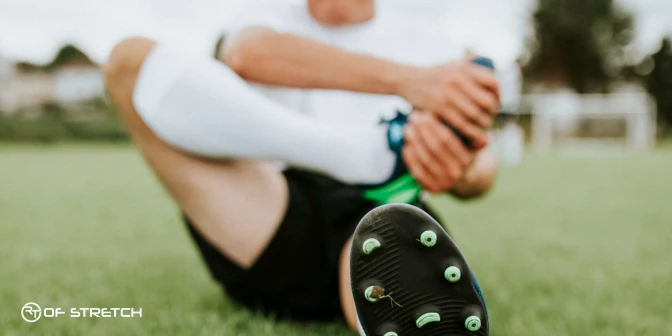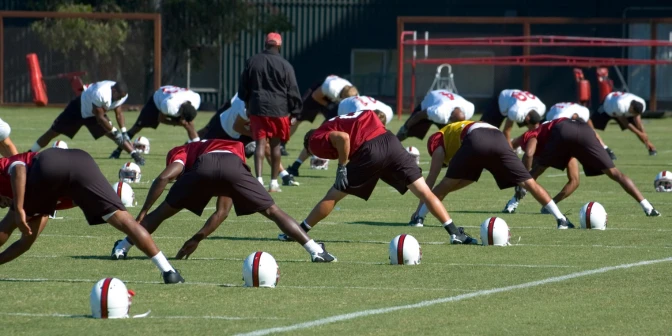The importance of stretching for
Football Players
Stretching is an often overlooked but essential aspect of a football player’s training regimen. It goes beyond warming up and cooling down; football stretches significantly enhance performance, prevent injuries, and promote long-term athletic longevity.
Whether you’re a professional athlete or an amateur enthusiast, incorporating proper stretching techniques into your routine can make all the difference on the field.
Why Football Players Need Stretching
Stretching goes beyond simply reaching for your toes or warming up before a match. For football players, it’s a vital practice that helps prevent injuries and improves overall performance.
The intense physical demands of football require your muscles and joints to be flexible and ready for quick, explosive movements. Without proper stretching, your risk of injury increases significantly, and your ability to perform at your best can be compromised.
Types of Football Stretches
Understanding the types of stretches and when to use them is critical to maximizing their benefits. Football players should focus on dynamic and static stretching to prepare their bodies for the sport’s rigors and recover afterward.
Dynamic Stretching (Before Training or Games)

Dynamic stretching involves engaging parts of your body through a range of motion, gradually increasing reach and speed. This type of stretching is ideal before a game or training session. It warms up your muscles and conditions them for the intense physical activity ahead.
- Walking Knee Hugs: This stretch improves hip mobility and increases flexibility in the glutes and hamstrings, which is crucial for quick sprints and agility on the field.
- Dynamic Lunge with Rotation: This stretch is perfect for increasing hip mobility and thoracic spine flexibility, enhancing a player’s sprint speed and agility.
- Frankenstein Walk: This exercise allows players to prevent strains during high-speed movements like running and kicking by stretching the hamstrings.
Static Stretching (After Training or Games)
Static stretching involves maintaining a stretch for a set period, usually 20 to 45 seconds. This type of stretching is best for cooling down after a game or training session. It helps reduce muscle stiffness and improve flexibility over time.
- Hamstring Stretch: Essential for runners, this stretch helps prevent injuries by maintaining the flexibility of the hamstrings.
- Posterior Capsule Stretch: This stretch keeps the shoulder muscles flexible, which benefits players who throw, like quarterbacks.
The Benefits of Regular Football Stretching
Including a regular stretching routine in your training program offers benefits beyond immediate physical effects.
1. Enhanced Recovery
Stretching after a game or workout helps quicker recovery by boosting blood circulation and decreasing muscle tension. This means you can return to the field faster, with less risk of injury or soreness.
2. Prolonged Athletic Longevity
Regular stretching helps prevent injuries and keeps your muscles and joints healthy. This can prolong your football career, allowing you to play at a high level for many years.
3. Mental Focus and Relaxation
Stretching can also have psychological benefits. The stretching routine can be a mental reset, helping you focus and relax before a game or unwind after a tough session. This mental clarity can translate into better performance on the field.
Suggested Stretching Routine for Football Players
Football players’ well-rounded stretching routine should include dynamic stretches before a game or training and static stretches afterward. This combination ensures your muscles are prepared for action and correctly cooled down to prevent stiffness and soreness.
Pre-Game/Training Routine:
- Incorporate dynamic stretches like walking knee hugs, dynamic lunges with rotation, and Frankenstein walks.
Post-Game/Training Routine:
- Use static stretches like the hamstring and posterior capsule stretch to cool down and maintain muscle flexibility.

Stretch Your Way to Success – Take Action Now!
Stretching is a simple yet powerful tool every football player should use to enhance their performance and protect their body from injuries. Integrating proper football stretches into your routine can improve flexibility, prevent injuries, and prolong your athletic career. Don’t underestimate the power of a good stretch—it could be the key to your success on the field.
Don’t wait until an injury sidelines you—start incorporating these essential stretches into your football training routine today! Feel free to contact us if you have any questions or need personalized advice on stretching techniques. Our team is here to help you achieve your best performance.
FAQs
How often should football players stretch?
Football players should stretch before and after every training session and game. Pre-game stretching helps warm up the muscles, while post-game stretching aids in recovery and flexibility. A routine will ensure long-term benefits.
Can stretching improve my football skills?
Yes, stretching can improve your football skills by increasing your flexibility and range of motion. These are crucial for movements like kicking, sprinting, and changing direction. Stretching also helps prevent injuries, allowing you to train consistently.
Is there a difference between stretching for football and other sports?
While stretching principles are similar across sports, football-specific stretches focus more on the hips, hamstrings, and shoulders due to the game’s unique movements and physical demands. It’s essential to tailor your stretching routine to football’s specific needs.